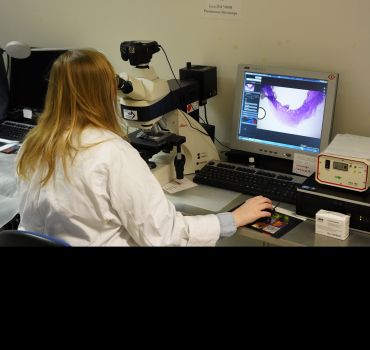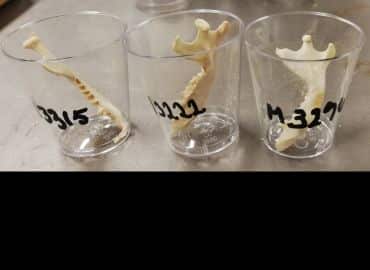World’s oldest European hedgehog found in citizen science project
Tuesday 14th Feb 2023, 2.59pm
I vividly remember the day when I counted 16 growth rings in the microscope. I was completely overwhelmed and even shed a tear of joy! Because if a hedgehog can reach an age of 16 years, there is still hope for the population.
Dr Sophie Lund Rasmussen, Wildlife Conservation Research Unit (WildCRU), Department of Biology, University of Oxford.
The European hedgehog is one of our most beloved mammals but populations have declined dramatically in recent years. In the UK, studies indicate that urban populations have fallen by up to 30% and rural populations by at least 50% since the turn of the century. To combat this, researchers and conservationists have launched various projects to monitor hedgehog populations, to inform initiatives to protect hedgehogs in the wild. These include “The Danish Hedgehog Project”, a citizen science project led by Dr Sophie Lund Rasmussen (aka ‘Dr Hedgehog’) of Oxford University’s Wildlife Conservation Research Unit, WildCRU, part of the Department of Biology.
During 2016, The Danish Hedgehog Project asked Danish citizens to collect any dead hedgehogs they found to better understand how long individual Danish hedgehogs typically live for. Over 400 volunteers collected an astonishing 697 dead hedgehogs originating from all over Denmark, with a roughly 50/50 split from urban and rural areas.
The world’s oldest hedgehog
 Dr Sophie Lund Rasmussen looks in the microscope to count year rings in a section of a hedgehog jawbone to determine the age of the hedgehog. Credit: Thomas Degner.
Dr Sophie Lund Rasmussen looks in the microscope to count year rings in a section of a hedgehog jawbone to determine the age of the hedgehog. Credit: Thomas Degner.The researchers determined the age of the dead hedgehogs by counting growth lines in thin sections of the hedgehogs’ jawbones, a method similar to counting growth rings in trees. Hedgehog jaw bones show growth lines because calcium metabolism slows down when they hibernate over winter. This causes bone growth to reduce markedly or even stop completely, resulting in growth lines where one line represents one hibernation.
The results showed that the oldest hedgehog in the sample was 16 years old – the oldest scientifically-documented European hedgehog ever found, and 7 years older than the previous record holder, which lived for 9 years. Two other individuals lived for 13 and 11 years respectively.
But despite these long-lived individuals, the average age of the hedgehogs was only around two years, and about a third (30%) of the hedgehogs died at or before the age of one year. Most (56%) of the hedgehogs had been killed when crossing roads, whilst 22% died at a hedgehog rehabilitation centre (for instance, following a dog attack), and 22% died of natural causes in the wild.
Dr Sophie Lund Rasmussen said: ’Although we saw a high proportion of individuals dying at the age of one year, our data also showed that if the individuals survived this life stage, they could potentially live to become 16 years old and produce offspring for several years. This may be because individual hedgehogs gradually gain more experience as they grow older. If they manage to survive to reach the age of two years or more, they would have likely learned to avoid dangers such as cars and predators.’
 Hedgehog jawbones which are used for age determination research. A hedgehog’s age can be worked out by counting year rings in sections of their jawbones. Credits: Sophie Lund Rasmussen.
Hedgehog jawbones which are used for age determination research. A hedgehog’s age can be worked out by counting year rings in sections of their jawbones. Credits: Sophie Lund Rasmussen.
The research also showed that male hedgehogs in general lived longer than females (2.1 vs 1.6 years, or 24% longer), which is uncommon in mammals. Male hedgehogs were also more frequently killed in traffic, especially in rural areas and during the month of July, which is the peak of the mating season for hedgehogs in Denmark.
Dr Sophie Lund Rasmussen said: ‘The tendency for males to outlive females is likely caused by the fact that it is simply easier being a male hedgehog. Hedgehogs are not territorial, which means that the males rarely fight. And the females raise their offspring alone. Sadly, many hedgehogs are killed in traffic each year, especially during the mating season in the summer, as the hedgehogs are walking long distances and are crossing more roads in their search for mates.’
Inbreeding does not appear to affect longevity in hedgehogs
The researchers also took tissue samples to investigate whether the degree of inbreeding influenced how long European hedgehogs live for. Previous studies have found that the genetic diversity of the Danish hedgehog population is low, indicating high degrees of inbreeding. This can reduce the fitness of a population by allowing hereditary, and potentially lethal, health conditions to be passed on between generations. Surprisingly, the results showed that inbreeding did not seem to reduce the expected lifespan of the hedgehogs.
The various findings of this study have improved our understanding of the basic life history of hedgehogs, and will hopefully improve the conservation management for this beloved and declining species.
Dr Sophie Lund Rasmussen, Wildlife Conservation Research Unit (WildCRU), Department of Biology, University of Oxford.
Dr Rasmussen said: ‘Sadly, many species of wildlife are in decline, which often results in increased inbreeding, as the decline limits the selection of suitable mates. Our research indicates that if the hedgehogs manage to survive into adulthood, despite their high degree of inbreeding, which may cause several potentially lethal, hereditary conditions, the inbreeding does not reduce their longevity. That is a rather ground-breaking discovery, and very positive news from a conservation perspective.’
The study ’Anyone Can Get Old—All You Have to Do Is Live Long Enough: Understanding Mortality and Life Expectancy in European Hedgehogs (Erinaceus europaeus)’ has been published in Animals.
You can learn more about Dr Sophie Lund Rasmussen’s work on her YouTube channel ‘Dr Hedgehog’ and by following her on Twitter: @Dr_Pindsvin
The study was published in collaboration with Associate Professor Owen Jones at Interdisciplinary Center on Population Dynamics (CPop), Institute of Biology, University of Southern Denmark, Senior Researcher Dr Thomas Bjørneboe Berg from Naturama, and Associate Professor Helle Jakobe Martens, Department of Geosciences and Natural Resource Management, Copenhagen University.

